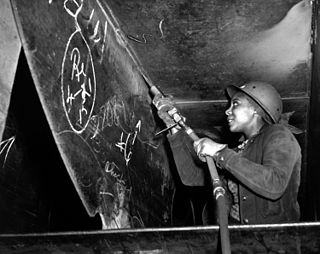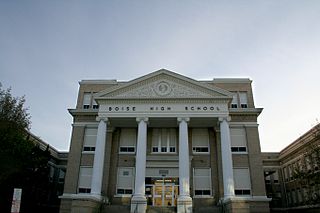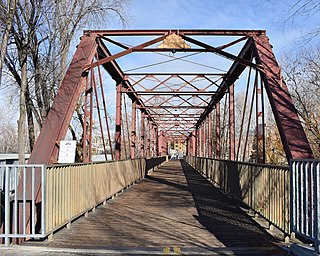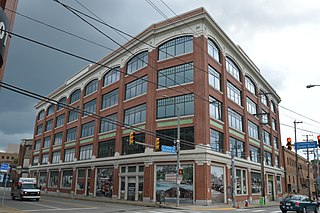
A motel, also known as a motor hotel, motor inn or motor lodge, is a hotel designed for motorists, usually having each room entered directly from the parking area for motor vehicles rather than through a central lobby. Entering dictionaries after World War II, the word motel, coined as a portmanteau of "motor hotel", originates from the Milestone Mo-Tel of San Luis Obispo, California, which was built in 1925. The term referred to a type of hotel consisting of a single building of connected rooms whose doors faced a parking lot and in some circumstances, a common area or a series of small cabins with common parking. Motels are often individually owned, though motel chains do exist.

Rosie the Riveter World War II Home Front National Historical Park is a United States national historical park located in Richmond, California, near San Francisco. The park preserves and interprets the legacy of the United States home front during World War II, including the Kaiser Richmond Shipyards, the Victory ship SS Red Oak Victory, a tank factory, housing developments and other facilities built to support America's entry into World War II. In particular, the role of women and African-Americans in war industries is explored and honored.

The Idaho State Capitol in Boise is the home of the government of the U.S. state of Idaho. Although Lewiston briefly served as Idaho's capital from the formation of Idaho Territory in 1863, the territorial legislature moved it to Boise on December 24, 1864.

Boise High School is a public secondary school in Boise, Idaho, one of five traditional high schools within the city limits, four of which are in the Boise School District. A three-year comprehensive high school, Boise High is located on the outlying edge of the city's downtown business core. The enrollment for the 2014–15 school year was approximately 1,481.

U.S. Route 66 is a former east–west United States Numbered Highway, running from Santa Monica, California to Chicago, Illinois. In Missouri, the highway ran from downtown St. Louis at the Mississippi River to the Kansas state line west of Joplin. The highway was originally Route 14 from St. Louis to Joplin and Route 1F from Joplin to Kansas. It underwent two major realignments and several lesser realignments in the cities of St. Louis, Springfield, and Joplin. Current highways covering several miles of the former highway include Route 100, Route 366, Route 266, Route 96, and Route 66. Interstate 44 (I-44) approximates much of US 66 between St. Louis and Springfield.

The historic U.S. Route 66 ran east–west across the central part of the state of New Mexico, along the path now taken by Interstate 40 (I-40). However, until 1937, it took a longer route via Los Lunas, Albuquerque, and Santa Fe, now roughly New Mexico State Road 6 (NM 6), I-25, and US 84. Large portions of the old road parallel to I-40 have been designated NM 117, NM 118, NM 122, NM 124, NM 333, three separate loops of I-40 Business, and state-maintained frontage roads.

The Wigwam Motels, also known as the "Wigwam Villages," is a motel chain in the United States built during the 1930s and 1940s. The rooms are built in the form of tipis, mistakenly referred to as wigwams. It originally had seven different locations: two locations in Kentucky and one each in Alabama, Florida, Arizona, Louisiana, and California.

The Aztec Motel, also known as the Aztec Auto Court or Aztec Lodge, was a historic motel located on former U.S. Route 66 in the Upper Nob Hill neighborhood of Albuquerque, New Mexico, United States. Until its demolition in 2011 it was the oldest continuously-operating Route 66 motel in New Mexico and "one of the five most important motels left" in Albuquerque.

The Boise Depot is a former train station in the western United States, located in Boise, Idaho. Opened 98 years ago in 1925, it is listed on the National Register of Historic Places (NRHP). At an elevation of 2,753 feet (839 m) above sea level on the rim of the first bench, the depot overlooks Capitol Boulevard and the Idaho State Capitol, one mile (1.6 km) to the northeast.

The Boots Motel, a historic U.S. Route 66 motor hotel in Carthage, Missouri, opened in 1939 as the Boots Court at 107 S. Garrison Avenue.

The Wagon Wheel Motel, Café and Station in Cuba, Missouri, is a 19-room independently owned historic U.S. Route 66 restored motel which has been serving travelers since 1938. The site opened as a café in 1936; the motel has remained in continuous operation since 1938. The motel rooms were fully restored in 2010, adding modern amenities such as HDTV and wireless Internet.

The El Vado Auto Court is a historic motel in Albuquerque, New Mexico, located along former U.S. Route 66. Built in 1937, it operated until 2005 and reopened in 2018 after renovations. The motel was listed on the New Mexico State Register of Cultural Properties and National Register of Historic Places in 1993, and was also designated an Albuquerque city landmark in 2008.

Mountain View Auto Court is a complex of motel buildings in southwestern Ogden, Utah, that is listed on the National Register of Historic Places.

The Capitol Boulevard Memorial Bridge, also known as the Oregon Trail Memorial Bridge, is a historic bridge over the Boise River in Boise, Idaho, United States. It is listed on the National Register of Historic Places.

The Boise Historic District in Boise, Idaho, includes late 19th century and early 20th century buildings constructed of brick, sandstone, or wood in an area roughly bounded by Capitol Boulevard, North 5th Street, West Main Street, and West Idaho Street. The district is located within an area known as Old Boise, and contributing properties were constructed 1879–1920.

The Carnegie Public Library is a Neoclassical building designed by Tourtellotte & Co. and constructed in Boise, Idaho, in 1904–1905. It was individually listed on the National Register of Historic Places in 1974. In 1982 it was included as a contributing property in the Fort Street Historic District.

The Hoff Building is an historic building in the western United States, located in Boise, Idaho. Designed by Boise architects Tourtellotte & Hummel, it was constructed 93 years ago in 1930 in the style of Art Deco. Known as Hotel Boise until 1976, the building is a contributing resource in the Boise Capitol Area District, listed on the National Register of Historic Places since May 12, 1976.

The Ninth Street Bridge in Boise, Idaho, also known as the Eighth Street Bridge, crosses the Boise River and is a 2-span, pin-connected Pratt through truss design constructed by the Missouri Valley Bridge & Iron Co. and completed in 1911. Each span is 160 ft (49 m) and includes six full panels and two end panels, supported by concrete piers at each end and midway in the river. Laced channel sections with cover plates form the upper chords, with eyebars on the lower chords. Eyebars with turnbuckles form the diagonals. The bridge was added to the National Register of Historic Places in 2001.

The Ford Motor Company Assembly Plant is a historic former automobile assembly plant in the Bloomfield neighborhood of Pittsburgh, Pennsylvania. Located along a stretch of Baum Boulevard nicknamed "Automobile Row" due to its high concentration of auto-related businesses, the plant was built in 1915 by Ford Motor Company to assemble Ford Model T cars using the company's pioneering mass production processes. It was designed by Ford's corporate architect John H. Graham, Sr. and constructed from reinforced concrete. The plant consists of an eight-story main building which contained the assembly areas and a vehicle showroom, and a six-story crane shed which was used to hoist parts unloaded from the adjacent Pennsylvania Railroad tracks to the appropriate level for assembly. Due to the steeply sloping site, the building has only five stories above grade along the street elevations.




















